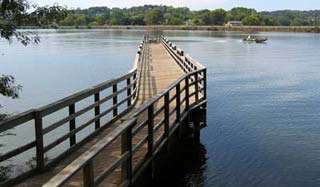Fort Loudoun Lake Fishing
category : Fishing
 Fort Loudoun is surrounded by private and commercial development and is used extensively for fishing and other aquatic recreations. The most commonly harvested fish are largemouth, smallmouth, and white bass. Bluegill, crappie, sauger, and catfish are also present in good numbers.
Fort Loudoun is surrounded by private and commercial development and is used extensively for fishing and other aquatic recreations. The most commonly harvested fish are largemouth, smallmouth, and white bass. Bluegill, crappie, sauger, and catfish are also present in good numbers.Health advisories issued by the Tennessee Department of Environment and Conservation against the consumption of catfish, largemouth bass over two pounds, and any largemouth bass from the Little River embayment are still in effect. These advisories are due to PCB contamination and account for the low number of fish harvested.
FISH HABITAT ENHANCEMENT:
Water level fluctuations are minimal and shoreline vegetation is well developed. Therefore, traditional enhancement work using brush to concentrate fish for anglers is not needed reservoir wide. Some recent rebrushing work has been done to attract fish to the pier at I.C. King Park. Fifty-five smallmouth bass spawning benches were placed in the lower section of the reservoir in 1996.
BLACK BASS:
Fort Loudoun Reservoir is well known for its quality largemouth and smallmouth bass fishing. As a result, many high dollar tournaments have recently been attracted to the Knoxville area.
Black bass accounted for 55% of the effort by anglers in the most recent TWRA angler survey in 2005. Eighty-five percent of the bass caught by all anglers were largemouth and 14% were smallmouth.
Information gathered from bass tournaments since 1993 have shown that Fort Loudoun contains a good bass fishery and a very high number of big fish. Large bass are also collected in very good numbers in TWRA's electrofishing surveys and a higher percentage of "lunkers" are found in Fort Loudoun when compared to most other east Tennessee reservoirs.
Anglers do not harvest many bass from the reservoir due to the health advisories. This is one reason for the good number of "lunkers" in the population. Bass fishing is expected to remain good for years to come because of the high release rate by anglers and the lake's good oxygen and fertility levels.
Anglers are allowed five largemouth or smallmouth in any combination with an 18-inch limit on smallmouth and a 14-inch limit on largemouth. Fifteen spotted bass are allowed per day with no minimum length limit.
CRAPPIE:
The TWRA's angler survey estimated that 24,824 crappie were taken home by anglers in 2005. Most of the crappie caught in Fort Loudoun are white crappie.
Anglers are allowed 15 crappie per day with a 10-inch minimum length limit.
SAUGER and WALLEYE:
A good number of sauger are caught and harvested annually from the reservoir. The TWRA's angler survey estimated that 10,129 were caught and 6,159 were harvested in 2005.
Anglers are allowed 10 sauger or walleye in combination per day with a 15-inch minimum length limit.
CATFISH:
Catfishing is excellent in Fort Loudoun. The state record 130-pound blue catfish was taken by commercial gear from Fort Loudoun in 1976. Flathead and channel catfish are also present in the reservoir.
Only one catfish over 34-inches may be harvested per day. There is not a harvest limit for catfish under 34-inches.
FISHING TIPS:
Spotted bass - Bridge riprap and similar rocky areas with small white spinners, plastic grubs on leadhead jigs, doll flies, and crawfish crankbaits.
Largemouth bass - Spring: Creek points and channels using shallow running crankbaits, spinner baits, buzz baits, Carolina-rigged floating worms, and Texas-rigged worms; Summer: River channel points and humps with deep running crankbaits and Carolina rigs; Fall: Creek mouths and river channel points using shallow running crankbaits and top water plugs; Winter: Creek mouths and river channels using crankbaits, jigs, and lizards.
Smallmouth bass - Spring: Creek mouths and river channel points with shallow running crankbaits, pig 'n jig, and grubs; Summer: River channel points and humps using deep running crankbaits and pig 'n jigs; Fall: River channels using shallow running crankbaits and topwater plugs; Winter: River channel near the dam using jigs, grubs and shiners.
Crappie - Spring: Creek channels in open water and brush with jigs, grubs, and minnows; Summer: River channels at night with jigs, grubs, and minnows; Fall and Winter: In creeks with jigs, grubs, and minnows.
Sauger - Spring: Upstream of Knoxville trolling with crankbaits or drifting with grubs, jigs, and minnows.
White bass - Little Turkey, Sinking, and Ish creeks offer good white bass fishing in the spring. They are abundant in the Tennessee River across from the UT Agricultural School and the French Broad and Holston Rivers above Knoxville.
Catfish - Blue, channel, and flathead catfish hit nightcrawlers, chicken livers, or shiners on rocky outcroppings, on flats near the channels, and in the rear of large hollows.
Address: In Knoxville, TN, I-75, Exit 81, E on Hwy 321
Phone: 423-587-7037
Come visit us in , Tennessee